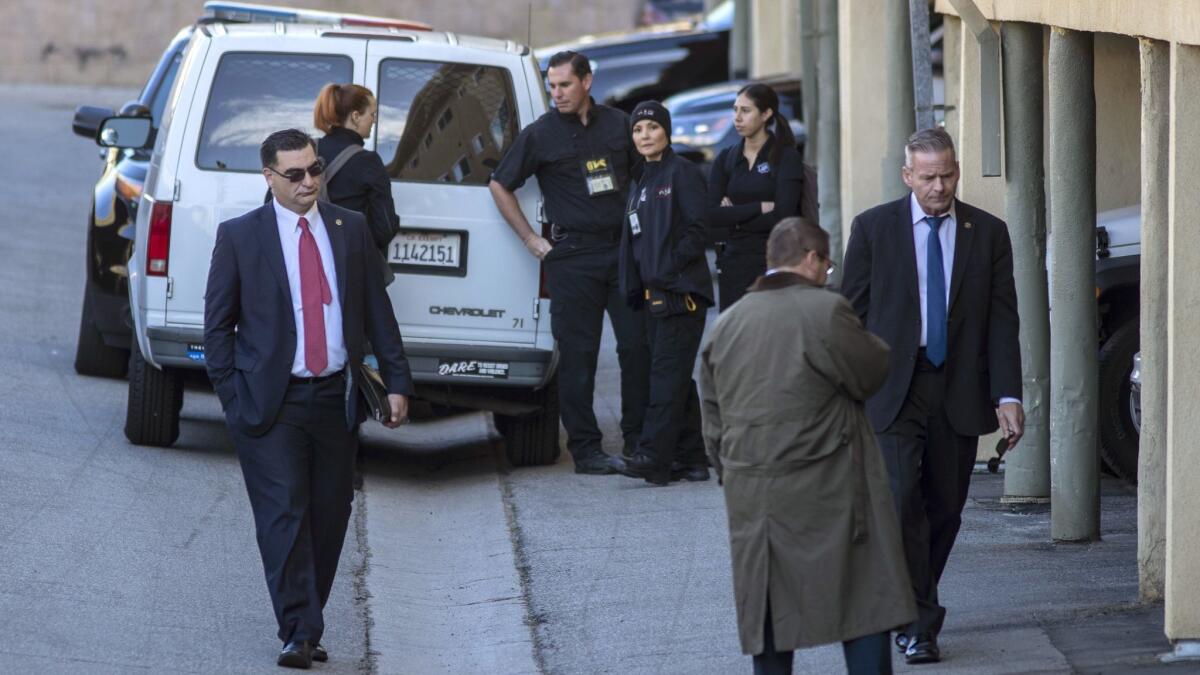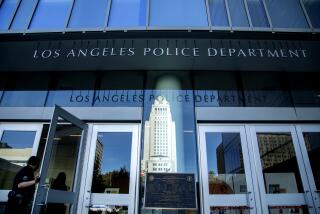Crime is down in Los Angeles for the first time in five years

For the first time in five years, violent crime was down in Los Angeles in 2018, with the number of homicides on track to be among the lowest in more than 50 years.
The data mirror an overall drop in crime this year in the parts of L.A. County patrolled by the Sheriff’s Department, as well as in San Francisco and Oakland.
After decades of steady decline, violent crime — which includes homicide, rape, robbery and aggravated assault — had begun climbing in 2014, with a spike in shootings in South L.A. causing particular concern.
The increase has prompted debate over whether statewide criminal justice reforms, including Proposition 47, which passed in November 2014 and has kept some low-level offenders out of jail, contributed to the upswing in crime.
Some law enforcement officials argue that offenders commit minor crimes knowing they face little to no jail time and having less incentive to enter drug treatment in exchange for more lenient sentences.
The backlash has led to a proposed statewide ballot measure that would reverse some provisions of Prop. 47, toughen supervision of parolees and disqualify some prisoners from early release.
This year, though, Los Angeles “turned a little bit of a corner,” said LAPD Chief Michel Moore.
Violent crime decreased by nearly 4%, though it was still 1% higher than two years ago, according to preliminary statistics through Dec. 8.
Overall, crime was down in all categories in 2018, except personal theft, which rose 3%. Property crime decreased by 2%, after increasing each year since 2015.
Moore attributed the decline to strategies the department implemented several years ago to combat violent crime, including stepped-up analysis of data and an expansion of the elite Metropolitan Division.
“We’re hitting our stride, we believe, in the execution of those strategies, which are not just police-centric, but are dealing with our communities and our partnerships and our engagement with our GRYD [Gang Reduction and Youth Development] resources and others,” said Moore, who became chief in June and previously headed the LAPD’s patrol operations.
With homicides at 256 through Dec. 27 — a 9% decline from last year — the city will achieve its ninth straight year of fewer than 300 homicides.
Gang-related homicides were down more than 20%, Moore said, pointing to LAPD-led youth programs and the work of gang interventionists who try to prevent retaliatory shootings by tamping down rumors and talking gang members out of revenge.
Los Angeles is a much safer city than in decades past. In 1992, nearly 90,000 violent crimes were reported, compared with fewer than 30,000 last year. Homicides also peaked in 1992, at 1,092, before plunging sharply in the 1990s and continuing to decline in the 2000s.
The number of homicides inched up starting in 2014, with last year’s tally of 282 marking the first decrease. The clearance rate — cases that are solved or otherwise considered closed — was 73% last year.
In the parts of L.A. County patrolled by the Sheriff’s Department, crime also was down this year, with statistics through Nov. 30 showing a 3% decline in homicides, a 5% decline in violent crime and an 8% decline in property crime.
One exception is Compton, which contracts with the Sheriff’s Department for law enforcement and has longstanding gang issues. Homicides rose from 15 last year to 19 this year, and violent crime was up 2%.
Elsewhere in California, the San Francisco Police Department, headed by LAPD veteran Bill Scott, reported a 25% drop in homicides, a 2% drop in violent crime and an 8% drop in property crime.
In Oakland, homicides were down slightly this year from the previous year, with total crime down 11%.
Charis Kubrin, a professor of criminology, law and society at UC Irvine, said L.A.’s decline in violent crime is impressive.
She could not pinpoint a cause, with societal factors such as the economy and illicit drug markets possibly playing a role. But the tactics officers use and how much residents trust police can affect homicide rates, in particular, she said.
Kubrin recently co-authored a study showing Prop. 47 probably was not the cause of an increase in some types of theft and that there was no link between the ballot measure and violent crime.
“Getting out there and being involved in the community, being as relentless as you can in identifying bad guys and also not overstepping boundaries — I see the LAPD’s efforts trending in a good way,” Kubrin said. “Other cities have much deeper divides between the police and the community.”
Next month, about 200 police officers who previously had been assigned to specialized units, including commercial crimes and Metro, will switch to street patrol or station detective assignments. The transfers are a response to a spike in calls for service and complaints from some residents about slow response times.
Calls for service, up by more than 150,000 since 2012, have increased in part because the LAPD now routes some non-urgent calls through dispatch rather than stations, where they would sometimes go unanswered, Moore said.
Combined with an earlier wave of reassignments, there will be about 550 more officers on the streets than a year-and-a-half ago, Moore said.
The city’s homeless population continues to pose a major challenge for the LAPD. The number of homeless people who were victims of crimes skyrocketed by 96% this year, with the largest increases in aggravated assaults, thefts and robberies, according to an LAPD report.
Cmdr. Dominic Choi, the department’s homelessness coordinator, said the startling statistic was partly a result of better reporting, but that there also was an increase in homeless crime victims.
“If I’m sitting in my house, the chance of being a victim of crime is less than if I’m sitting outside on the street every night,” he said at a recent Police Commission meeting.
Arrests of homeless people for felonies increased 12% this year. But there was a decrease in arrests of homeless people for misdemeanors, as well as a drop in citations for offenses such as sleeping on the sidewalk and possessing a shopping cart on the street.
Leonard Delpit, a member of the Central Area Neighborhood Development Council in South L.A., said homeless people in his area clash with business owners and are thought to occasionally be responsible for crimes, including break-ins.
At West Vernon and South Western avenues, a liquor store and a burger stand are magnets for loitering and occasional robberies, with gang members sometimes hanging out there, according to Delpit, who has lived near the corner for 40 years.
LAPD officers have been patrolling the area more frequently, but Delpit said he wishes they were around more and cracked down on troublemakers more consistently. He pointed to the Harvard Park neighborhood, where a community policing program has helped reduce homicides from nine in 2016 to two in 2018.
“The police are doing a good job in the Harvard Park area, but that’s not good enough for the entire area,” Delpit said. “The community wants more.”
In the LAPD’s South Bureau, which includes much of South L.A., homicides were down 2%, violent crime was down 4% and property crime was down 3%, though theft from a vehicle and personal theft were up. The number of shooting victims, 478, was down 1% from last year and down 17% from two years ago.
But some parts of the city that have traditionally been considered safe have seen significant jumps in crime.
In the LAPD’s Wilshire Division, which includes Fairfax, Hancock Park, Miracle Mile and nearby neighborhoods, robberies and aggravated assaults were up nearly 30% and property crime was up 18% from two years ago.
Angela Guzman, chair of public safety for the Mid City West Community Council, said people have been smashing car windows to steal phones and other valuables.
Guzman, who manages a property near West 3rd Street and South Crescent Heights Boulevard, is working with the LAPD to increase neighborhood watch patrols and urge residents not to leave anything inside their cars.
“They want to feel safe, and they’re not feeling safe,” she said of residents in the area.
In the San Fernando Valley, police have made inroads against property crime through rigorous data analysis techniques pioneered to combat violent crime. In Valley Bureau, burglaries were down 12% and personal thefts down 4%, with overall property crime down 6% from last year.
Deputy Chief Kris Pitcher said the data analysis is performed daily, with station captains focusing on “anchor points” such as stores, group homes or parks where there are clusters of crimes. Volunteer patrols, which began this year and include about 350 volunteers in tiny BMW i3s, also have helped deter would-be burglars in hillside areas that are targets for break-ins, Pitcher said.
The LAPD’s use of data has been criticized by activists from the Stop LAPD Spying Coalition and other organizations, who say that zeroing in on hot spots puts officers on high alert and makes them more likely to inflict violence on black and Latino residents.
At a recent Police Commission meeting, activists yelled “shame on you” and “opposed,” as the commissioners approved a $35,000 donation to improve technology at West Bureau’s data analysis center.
One activist, T. Guerra, called it “essentially a command center from which the community is surveilled.”
Moore said that going forward, he wants to focus on prevention more than arrests or sanctions, particularly when it comes to homeless people.
“I do believe the next iteration of safety in Los Angeles is a continued expansion of resources for homeless individuals — outreach workers, mental health workers, safe parking programs, latrines, showers, storage,” he said.
For more news on the Los Angeles Police Department, follow me on Twitter: @cindychangLA
More to Read
Sign up for Essential California
The most important California stories and recommendations in your inbox every morning.
You may occasionally receive promotional content from the Los Angeles Times.










